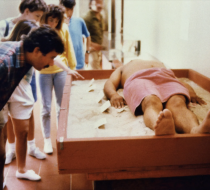James Luna’s “The Artifact Piece” (1987) Favorite
The performance artist James Luna, who died in 2018 at age 68, had a wicked sense of humor, which made his explorations of the way that Indigenous people have long been objectified, especially in museums, painfully piquant. A member of the California Luiseño tribe — and of Puyukitchum, Ipai and Mexican American Indian descent — who lived much of his life on reservation land in San Diego County, Luna staged his most famous work, which came to be known as “The Artifact Piece,” in 1987 at the anthropology-focused Museum of Man (now the Museum of Us) in the nearby Balboa Park. In it, Luna laid for hours at a time in a vitrine, wearing just a loin cloth. Around him, labeled as though for an anthropological exhibit, were such objects as his divorce papers and his college diploma. Even the scars on his body were labeled with deadpan panache. Luna’s occasional yawns and stretches jarred the viewer by disrupting the passive stance the artist was critiquing. “Americans,” Luna once said, “like romance more than they like the truth.” — N.H.







